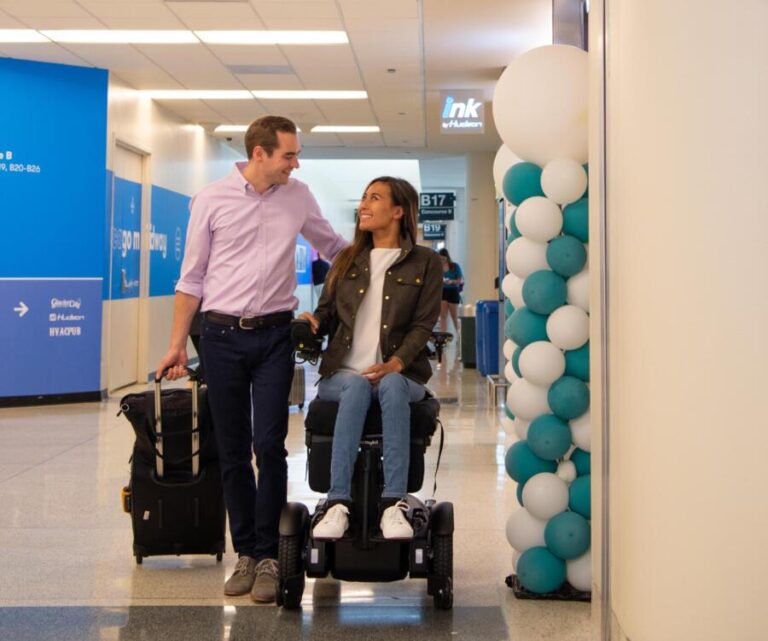Chicago’s Progressive Vision: Redefining Accessibility for an Inclusive Urban Future
Expanding Accessibility: From Physical Adaptations to Digital and Social Empowerment
Chicago is pioneering a comprehensive redefinition of accessibility that transcends traditional physical modifications like ramps and tactile signage.City officials are now emphasizing digital inclusion and social engagement to ensure that all residents, including those with disabilities, can participate fully in civic life. This includes enhancing the usability of municipal websites,increasing affordable broadband availability,and designing public spaces that celebrate diversity and foster community interaction.
These initiatives are the result of collaborative efforts involving disability rights advocates, technology experts, and social service professionals. The city’s multifaceted strategy is built on three foundational pillars:
- Equitable technology access: Distributing accessible devices and developing user-friendly digital platforms.
- Strategic community alliances: Partnering with nonprofit organizations to broaden outreach and deepen impact.
- Awareness and education campaigns: Promoting empathy and inclusive mindsets across the population.
| Focus Area | Key Initiatives | Anticipated Outcomes |
|---|---|---|
| Digital Accessibility | Enhanced website design, subsidized internet access | Greater engagement with online city services |
| Social Inclusion | Community hubs, culturally diverse programming | Strengthened social bonds and participation |
| Policy & Advocacy | Updated legislation, advisory boards with lived experience | Long-term systemic reforms and depiction |
Community Voices Driving Holistic Accessibility Policy Development
Chicago’s leadership is actively incorporating feedback from a broad spectrum of stakeholders-including disability advocates, entrepreneurs, and everyday residents-to craft accessibility policies that address complex, real-world challenges.This inclusive approach moves beyond mere regulatory compliance, focusing instead on creating environments that are genuinely welcoming and usable for everyone. Public spaces, transit systems, and digital platforms are all being adapted to reflect this evolving vision.
Recent community forums have underscored several critical priorities:
- Comprehensive design principles: Incorporating sensory-friendly features and intuitive wayfinding alongside traditional accessibility elements.
- Affordable technology access: Ensuring that assistive devices and digital services are within reach for all residents.
- Community-led accountability: Establishing oversight groups to evaluate the fairness and effectiveness of accessibility initiatives.
| Sector | Community Recommendations | Implementation Plans |
|---|---|---|
| Public Transit | Enhanced audio announcements, live service updates | Modernize communication infrastructure |
| Public Facilities | Improved tactile markers, optimized lighting | Revise building codes and standards |
| Digital Platforms | Accessible websites and mobile applications | Conduct citywide digital accessibility audits |
Empowering Education and Workforce Inclusion for People with Disabilities
Chicago is advancing innovative programs aimed at boosting educational attainment and employment opportunities for individuals with disabilities. These efforts tackle not only physical barriers but also systemic obstacles that hinder access to learning and career advancement. By collaborating with schools, employers, and nonprofit organizations, the city is cultivating supportive environments tailored to diverse needs. Key components include personalized mentorship, skill-building workshops, and the integration of adaptive technologies to foster equitable growth.
Highlighted program features include:
- Career planning initiatives: Focused training on both technical competencies and interpersonal skills.
- Diverse hiring collaborations: Partnering with businesses to develop inclusive recruitment pipelines.
- Mentorship networks: Connecting participants with seasoned professionals for guidance and support.
- Accessible educational tools: Leveraging advanced technologies to ensure equal learning opportunities.
| Program Name | Primary Focus | Measured Impact |
|---|---|---|
| Employment Pathways | Job training and placement | More than 600 job placements in the past year |
| Success Skills Workshops | Soft skills and technical training | 85% participant satisfaction rate |
| MentorLink | Professional mentorship programs | 120 active mentor-mentee partnerships |
Fostering Cross-Sector Collaboration for Sustainable Accessibility Progress
Achieving lasting accessibility improvements in Chicago requires a concerted effort among government bodies, private enterprises, community organizations, and academic institutions. Breaking down traditional silos,these stakeholders are encouraged to engage in continuous dialog and joint initiatives that produce scalable,impactful solutions. This collaborative model harnesses diverse expertise and resources to dismantle systemic barriers in public transportation, housing, and communal spaces.
Core strategies include:
- Integrated data sharing: Utilizing shared platforms to monitor progress and identify gaps in accessibility.
- Co-funded innovation projects: Pooling resources to support aspiring,transformative programs.
- Inclusive policy development: Embedding accessibility requirements throughout all stages of planning and implementation.
| Sector | Contribution to Accessibility | Collaboration Opportunities |
|---|---|---|
| Government | Regulatory oversight and infrastructure investment | Policy harmonization and funding allocation |
| Private Industry | Technological innovation and project execution | Development of accessible products and services |
| Community Organizations | Advocacy and user experience feedback | Awareness campaigns and participatory research |
| Academic Institutions | Research and impact evaluation | Evidence-based policy recommendations and data analysis |
Looking Ahead: Chicago’s Commitment to Inclusive Urban Living
As Chicago continues to reshape its accessibility framework, the city is setting a new benchmark for inclusivity that challenges outdated norms. By reimagining infrastructure, policy, and community engagement, Chicago is crafting an environment that genuinely serves all its residents. This progressive trajectory not only reflects a paradigm shift in urban development but also offers a replicable model for cities nationwide. The impact of these initiatives will become increasingly evident as Chicagoans with disabilities experience enhanced access and possibility in the years to come.








